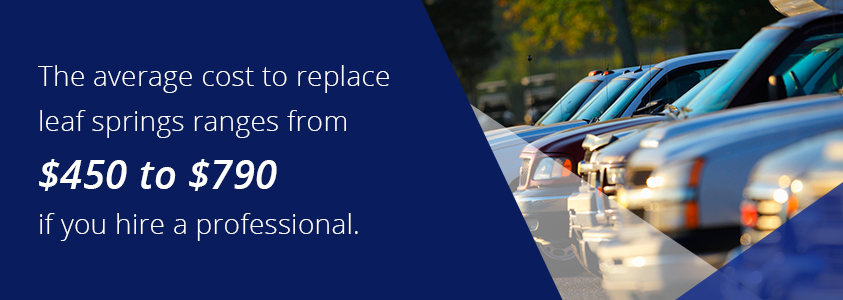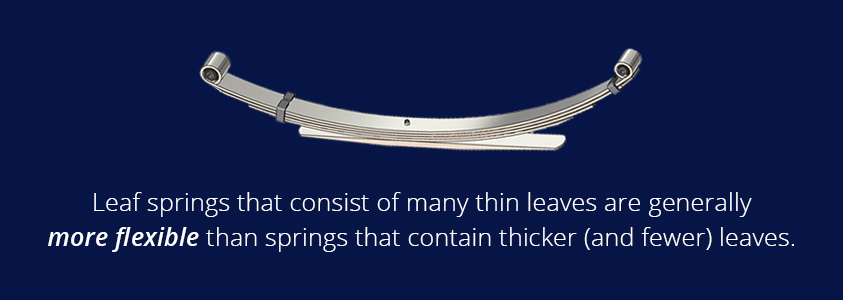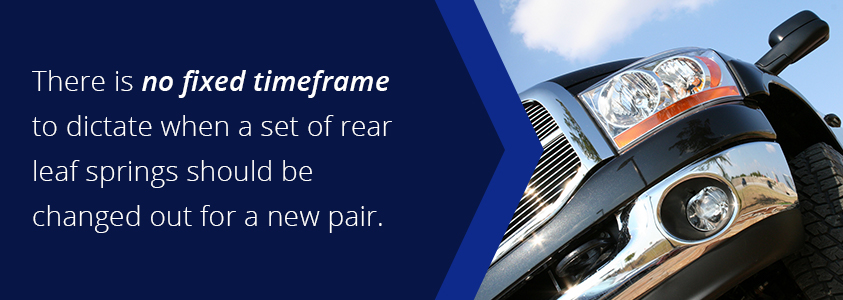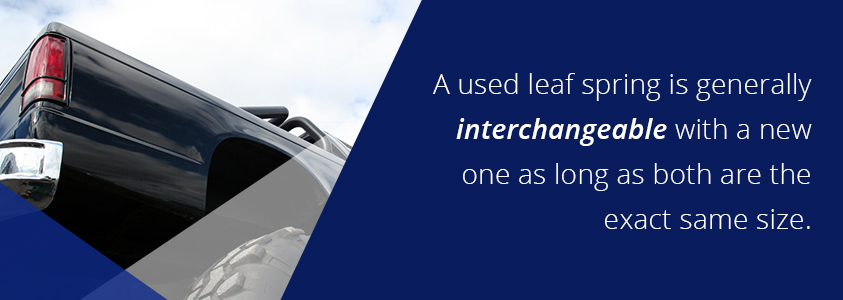Leaf Spring Replacement Cost

The price of leaf springs can vary depending on whether you do the installation yourself or have the new springs professionally installed. So how much does it cost to change leaf springs when you do it yourself? Depending on the make and model of the truck and the number of leaves on a spring, a single leaf spring will generally cost anywhere from $69.99 to $149.99. Therefore, at the lower-priced end of the spectrum, a new pair of leaf springs could cost you roughly $139.98.
Then again, these prices apply if you choose to do a DIY installation. So how much does it cost to replace rear springs when you hire a professional?
How Much Do New Leaf Springs Cost?

The average cost to replace leaf springs ranges from
$450 to $790 if you hire a professional. These estimates include the cost of labor in addition to the springs and parts. The cost of the installation alone could range from $95 to $170 depending on where you go. The remaining $355 to $620 accounts for the going rate on new leaf springs when purchased as part of an installation job as well as any additional parts that might be necessary.
The cost to repair broken leaf spring assemblies is somewhat lower if it merely involves touch-ups or re-arching. For instance, if you only need to have rust moved from an otherwise intact set of leaf springs, the cost should not exceed that of any general truck maintenance. If you need to have a spring re-arched — where additional leaves are added to a spring — you will need to factor in the cost of the new leaf in addition to the labor.
When suspension leaf spring replacement cost figures are taken into account, the importance of the investment must be stressed. Simply put, a truck cannot be used if it doesn't have a healthy set of leaf springs. In order to fully understand this, it's important to know how leaf springs work and how to identify the warning signs of bad leaf springs.
What Do Rear Leaf Springs Do?
Leaf springs make it possible for a truck to withstand the shock of turbulence on any given driving terrain. Thanks to leaf springs, the bumps and tremors the wheels encounter are softened before the motion can travel up through the chassis and into the cab. Leaf springs allow you to drive more comfortably on rocky and uneven roads and help slow down some of the wear on your chassis and engine components.
What leaf springs do is support the weight of the vehicle. When vehicular motion is triggered by turbulent roads and obstructions, the flexible firmness of the springs helps to slow the motion of everything above the axles. Therefore, instead of a truck experiencing rattling motions when the wheels make contact with road bumps and obstructions, the chassis and cab are effectively cushioned from the movement below.
How Do Rear Leaf Springs Work?
Leaf springs support the rear of a truck along each side, at the axle, next to the rear wheel. The bottom leaf on a spring — the shortest leaf — rests on top of the axle. Each end of the spring connects to an underside latch. Each spring is contoured to a slight dip.
When turbulence is encountered, the firm yet flexible presence of the springs helps keep the tires in contact with the road by holding down the axle. This same firmness and flexibility prevents the axle from jumping and sending shock throughout the vehicle.

For trucks, leaf springs are generally thick. Each spring will typically consist of at least six leaves and in some cases double that number. Leaf springs that consist of many thin leaves are generally more flexible than springs that contain thicker, yet fewer, leaves. When a set of leaf springs lacks sufficient flexibility, the driving experience is liable to feel stiffer.
Signs That It Is Time to Buy New Leaf Springs
If something about your driving experience feels off, it could be a sign that your leaf springs need to be replaced. Signs of worn leaf springs include a range of odd vehicular movements that make driving feel less comfortable. Some of the most common symptoms of worn leaf springs include the following:
- Sagging: If the vehicle sags in one direction or another, it is likely an indicator that the leaf springs are either worn or in need of an adjustment. For example, if it feels as if you are in a recliner chair while seated behind the wheel, the issue is probably down to a sagging rear suspension system. If you also feel a slight sideways sag, one of the springs is probably far more worn than the other.
- Teetering: If the truck starts to teeter more and more as you drive along assorted terrain, the leaf springs have probably lost their ability to give your vehicle adequate suspension. A tell-tale sign is when the vehicle becomes bouncy along routes where it had once ridden smoothly. What this means is that the springs can no longer absorb shocks like they did before.
- Excessive rolling: One of the scarier symptoms of worn leaf springs is when a truck rolls excessively at turns. If you have noticed this problem during recent turns at intersections or when pulling in and out of driveways, inspect your leaf springs immediately.
- Loss of traction: The scariest symptom of all is when a truck loses traction on the road. If the rear wheels lose contact with the roadway for seconds at a time while riding over gravelly or uneven terrain, the problem is most likely due to weakened or broken leaf springs that no longer hold the axle in its place.

- Rattling: If a truck rattles as you drive, it generally means the leaf springs are not doing their job properly. After all, a rear suspension system is designed to absorb the shock of road imperfections and smooth out the ride.
- Discomfort: Perhaps the most obvious sign is the one that doesn't require much vehicular knowledge in order to diagnose — an uncomfortable driving experience. If driving causes you and your passengers discomfort due to shaking, jumping, rattling and slouching in the cab, the problem is likely down to a weakened set of leaf springs.
- Tire wear: If your tires have rapidly worn in recent months, chances are good they are being forced to bear undue weight from your vehicle. This should be especially obvious if the tires were freshly installed within the last couple years and yet appear to have worn out before their time. After all, leaf springs are supposed to soften the pressure between the body of the vehicle and the ground underneath.
As soon as you notice premature or excessive wear on your tires — in particular, disproportionate wear to the back tires — take a flashlight and examine the underside components of the suspension system. If you spot wear along the U-bolts and shackles, the problem is definitely down to the leaf springs. You might even notice cracks, chips and rust along the springs. In any case, your truck is due for a new set of leaf springs.
Is It Safe to Drive With Bad Rear Leaf Springs?
It can depend on the severity of the problem, but generally, no — a problem with your leaf springs should be remedied as soon as possible. For starters, the driving discomfort that might have brought the problem to your attention is liable to get worse as the problem advances. If you ignore the issue, the problem could advance more rapidly and render your vehicle dangerous.
Every truck needs a balanced suspension system. Without this balanced support, undue weight is placed on one or both of the rear wheels. When the suspension lacks balance, the truck will drive less evenly and lose contact with the road as you drive. This can be especially dangerous as you make sharp turns or drive along uneven roads and mountainous routes.
A weak suspension system can also make it hazardous to brake your truck abruptly when needed. In a worst-case scenario, a truck with bad leaf springs might spin out of control or overturn if the brakes are slammed because of a sudden need to stop.
As a general rule, cracked leaf springs should be replaced as soon as possible — and a truck with broken springs should not be driven at all until the issue is fixed.
How Often Should Leaf Springs Be Replaced?
Leaf spring failure is not one of the more commonly encountered problems with most of today's trucks. In fact, many truck owners never need to replace the springs for the time that they own a given vehicle. Moreover, problems with leaf springs can often be handled with partial replacement. For example, if you notice that one of the leaves is cracked or chipped but the others are fine, you could opt to simply trade out that leaf for a new one.

What all of this really means is that there is no fixed timeframe to dictate when a set of rear leaf springs should be changed out for a new pair. However, when springs do go bad or fail outright, the problem should be handled immediately. If you continue to drive a truck with failing springs, the axle could become bent and render the vehicle even more unsafe.
In the majority of cases where springs fail, the problem is down to excess weight on the rear suspension system. If the rear of the vehicle sags, it might be due to spring failure, but it could also be due to inadequate springs in need of more leaves.
Should Rear Leaf Springs Be Altered?
The leaf springs that come with a truck are specifically manufactured to accommodate the weight, size dimensions and load capacity of that particular vehicle. Therefore, when you replace a set of rear leaf springs, it is crucial to make sure the new pair matches these specifications.
That said, you can augment an existing pair of springs if you have a special need to boost the suspension. For example, if you regularly max out the load capacity to haul large and heavy equipment over grueling terrain and long distance routes, it might be in your best interest to augment the springs with extra leaves.
After all, while pre-existing springs are optimized for maximum loads, it is generally assumed that vehicular use of this nature is rare among most drivers. Consequently, a conventional set of leaf springs can wear down more rapidly if the suspension is regularly pushed to the limit.
How Do New Leaf Springs Improve Performance?
If the driving quality of your truck has slowly declined over the past year, but you have just now traced the problem to your leaf springs, a new pair of leaf springs will indeed improve the vehicle from its recent performance patterns. The improvement is best described as a "restoration" of the vehicle's original driving capabilities.

A used leaf spring is generally interchangeable with a new one as long as both are the exact same size. Therefore, when you replace an old leaf spring with a duplicate, it will restore the performance of the truck to its earlier driving condition. However, in order to boost the weight limit of the vehicle, you will need to add more leaves.
If you do decide to add leaves for hauling purposes, remember that the payload of the axle can never be increased. If the vehicle is loaded past this limit, the pressure is liable to wear down the axle shafts and wheel bearings. In some cases, overloading can even ruin the transmission and certain engine components.
How Can Leaf Springs Be Replaced?
In order to replace a set of leaf springs, a truck must first be raised onto jack stands so the underside components can be accessed. Then, the wheels must be removed so that the springs can be reached. From there, the old springs can be dislodged and set aside to make way for the replacement springs. Of course, all of these steps involve more detail than we can go into here.
Can Leaf Springs Be Replaced DIY at Home?
If you read and understand the instructions on how to replace leaf springs, you can do the installation work yourself as long as you have the necessary tools close at hand. The first time you do this kind of installation, the project could take several hours to complete. Therefore, you will need to set aside an afternoon for your first DIY leaf spring replacement.
Once you get the hang of it all — from the removal of tires to the change-out of springs — subsequent repairs and enhancements to your leaf springs will probably take far less time.
Buy New Leaf Springs From General Spring
So how much does it cost to replace a leaf spring? Not a whole lot when you go the DIY installation route and buy leaf springs from General Spring. Browse our catalog to see our range of low-cost leaf springs, coil springs and leaves. At General Spring, we can help you select the right spring for the make and model or your truck, regardless of the age or rarity of the vehicle. Contact us today for more information.
Leaf Spring Replacement Cost

The price of leaf springs can vary depending on whether you do the installation yourself or have the new springs professionally installed. So how much does it cost to change leaf springs when you do it yourself? Depending on the make and model of the truck and the number of leaves on a spring, a single leaf spring will generally cost anywhere from $69.99 to $149.99. Therefore, at the lower-priced end of the spectrum, a new pair of leaf springs could cost you roughly $139.98.
Then again, these prices apply if you choose to do a DIY installation. So how much does it cost to replace rear springs when you hire a professional?
How Much Do New Leaf Springs Cost?

The average cost to replace leaf springs ranges from
$450 to $790 if you hire a professional. These estimates include the cost of labor in addition to the springs and parts. The cost of the installation alone could range from $95 to $170 depending on where you go. The remaining $355 to $620 accounts for the going rate on new leaf springs when purchased as part of an installation job as well as any additional parts that might be necessary.
The cost to repair broken leaf spring assemblies is somewhat lower if it merely involves touch-ups or re-arching. For instance, if you only need to have rust moved from an otherwise intact set of leaf springs, the cost should not exceed that of any general truck maintenance. If you need to have a spring re-arched — where additional leaves are added to a spring — you will need to factor in the cost of the new leaf in addition to the labor.
When suspension leaf spring replacement cost figures are taken into account, the importance of the investment must be stressed. Simply put, a truck cannot be used if it doesn't have a healthy set of leaf springs. In order to fully understand this, it's important to know how leaf springs work and how to identify the warning signs of bad leaf springs.
What Do Rear Leaf Springs Do?
Leaf springs make it possible for a truck to withstand the shock of turbulence on any given driving terrain. Thanks to leaf springs, the bumps and tremors the wheels encounter are softened before the motion can travel up through the chassis and into the cab. Leaf springs allow you to drive more comfortably on rocky and uneven roads and help slow down some of the wear on your chassis and engine components.
What leaf springs do is support the weight of the vehicle. When vehicular motion is triggered by turbulent roads and obstructions, the flexible firmness of the springs helps to slow the motion of everything above the axles. Therefore, instead of a truck experiencing rattling motions when the wheels make contact with road bumps and obstructions, the chassis and cab are effectively cushioned from the movement below.
How Do Rear Leaf Springs Work?
Leaf springs support the rear of a truck along each side, at the axle, next to the rear wheel. The bottom leaf on a spring — the shortest leaf — rests on top of the axle. Each end of the spring connects to an underside latch. Each spring is contoured to a slight dip.
When turbulence is encountered, the firm yet flexible presence of the springs helps keep the tires in contact with the road by holding down the axle. This same firmness and flexibility prevents the axle from jumping and sending shock throughout the vehicle.

For trucks, leaf springs are generally thick. Each spring will typically consist of at least six leaves and in some cases double that number. Leaf springs that consist of many thin leaves are generally more flexible than springs that contain thicker, yet fewer, leaves. When a set of leaf springs lacks sufficient flexibility, the driving experience is liable to feel stiffer.
Signs That It Is Time to Buy New Leaf Springs
If something about your driving experience feels off, it could be a sign that your leaf springs need to be replaced. Signs of worn leaf springs include a range of odd vehicular movements that make driving feel less comfortable. Some of the most common symptoms of worn leaf springs include the following:
- Sagging: If the vehicle sags in one direction or another, it is likely an indicator that the leaf springs are either worn or in need of an adjustment. For example, if it feels as if you are in a recliner chair while seated behind the wheel, the issue is probably down to a sagging rear suspension system. If you also feel a slight sideways sag, one of the springs is probably far more worn than the other.
- Teetering: If the truck starts to teeter more and more as you drive along assorted terrain, the leaf springs have probably lost their ability to give your vehicle adequate suspension. A tell-tale sign is when the vehicle becomes bouncy along routes where it had once ridden smoothly. What this means is that the springs can no longer absorb shocks like they did before.
- Excessive rolling: One of the scarier symptoms of worn leaf springs is when a truck rolls excessively at turns. If you have noticed this problem during recent turns at intersections or when pulling in and out of driveways, inspect your leaf springs immediately.
- Loss of traction: The scariest symptom of all is when a truck loses traction on the road. If the rear wheels lose contact with the roadway for seconds at a time while riding over gravelly or uneven terrain, the problem is most likely due to weakened or broken leaf springs that no longer hold the axle in its place.

- Rattling: If a truck rattles as you drive, it generally means the leaf springs are not doing their job properly. After all, a rear suspension system is designed to absorb the shock of road imperfections and smooth out the ride.
- Discomfort: Perhaps the most obvious sign is the one that doesn't require much vehicular knowledge in order to diagnose — an uncomfortable driving experience. If driving causes you and your passengers discomfort due to shaking, jumping, rattling and slouching in the cab, the problem is likely down to a weakened set of leaf springs.
- Tire wear: If your tires have rapidly worn in recent months, chances are good they are being forced to bear undue weight from your vehicle. This should be especially obvious if the tires were freshly installed within the last couple years and yet appear to have worn out before their time. After all, leaf springs are supposed to soften the pressure between the body of the vehicle and the ground underneath.
As soon as you notice premature or excessive wear on your tires — in particular, disproportionate wear to the back tires — take a flashlight and examine the underside components of the suspension system. If you spot wear along the U-bolts and shackles, the problem is definitely down to the leaf springs. You might even notice cracks, chips and rust along the springs. In any case, your truck is due for a new set of leaf springs.
Is It Safe to Drive With Bad Rear Leaf Springs?
It can depend on the severity of the problem, but generally, no — a problem with your leaf springs should be remedied as soon as possible. For starters, the driving discomfort that might have brought the problem to your attention is liable to get worse as the problem advances. If you ignore the issue, the problem could advance more rapidly and render your vehicle dangerous.
Every truck needs a balanced suspension system. Without this balanced support, undue weight is placed on one or both of the rear wheels. When the suspension lacks balance, the truck will drive less evenly and lose contact with the road as you drive. This can be especially dangerous as you make sharp turns or drive along uneven roads and mountainous routes.
A weak suspension system can also make it hazardous to brake your truck abruptly when needed. In a worst-case scenario, a truck with bad leaf springs might spin out of control or overturn if the brakes are slammed because of a sudden need to stop.
As a general rule, cracked leaf springs should be replaced as soon as possible — and a truck with broken springs should not be driven at all until the issue is fixed.
How Often Should Leaf Springs Be Replaced?
Leaf spring failure is not one of the more commonly encountered problems with most of today's trucks. In fact, many truck owners never need to replace the springs for the time that they own a given vehicle. Moreover, problems with leaf springs can often be handled with partial replacement. For example, if you notice that one of the leaves is cracked or chipped but the others are fine, you could opt to simply trade out that leaf for a new one.

What all of this really means is that there is no fixed timeframe to dictate when a set of rear leaf springs should be changed out for a new pair. However, when springs do go bad or fail outright, the problem should be handled immediately. If you continue to drive a truck with failing springs, the axle could become bent and render the vehicle even more unsafe.
In the majority of cases where springs fail, the problem is down to excess weight on the rear suspension system. If the rear of the vehicle sags, it might be due to spring failure, but it could also be due to inadequate springs in need of more leaves.
Should Rear Leaf Springs Be Altered?
The leaf springs that come with a truck are specifically manufactured to accommodate the weight, size dimensions and load capacity of that particular vehicle. Therefore, when you replace a set of rear leaf springs, it is crucial to make sure the new pair matches these specifications.
That said, you can augment an existing pair of springs if you have a special need to boost the suspension. For example, if you regularly max out the load capacity to haul large and heavy equipment over grueling terrain and long distance routes, it might be in your best interest to augment the springs with extra leaves.
After all, while pre-existing springs are optimized for maximum loads, it is generally assumed that vehicular use of this nature is rare among most drivers. Consequently, a conventional set of leaf springs can wear down more rapidly if the suspension is regularly pushed to the limit.
How Do New Leaf Springs Improve Performance?
If the driving quality of your truck has slowly declined over the past year, but you have just now traced the problem to your leaf springs, a new pair of leaf springs will indeed improve the vehicle from its recent performance patterns. The improvement is best described as a "restoration" of the vehicle's original driving capabilities.

A used leaf spring is generally interchangeable with a new one as long as both are the exact same size. Therefore, when you replace an old leaf spring with a duplicate, it will restore the performance of the truck to its earlier driving condition. However, in order to boost the weight limit of the vehicle, you will need to add more leaves.
If you do decide to add leaves for hauling purposes, remember that the payload of the axle can never be increased. If the vehicle is loaded past this limit, the pressure is liable to wear down the axle shafts and wheel bearings. In some cases, overloading can even ruin the transmission and certain engine components.
How Can Leaf Springs Be Replaced?
In order to replace a set of leaf springs, a truck must first be raised onto jack stands so the underside components can be accessed. Then, the wheels must be removed so that the springs can be reached. From there, the old springs can be dislodged and set aside to make way for the replacement springs. Of course, all of these steps involve more detail than we can go into here.
Can Leaf Springs Be Replaced DIY at Home?
If you read and understand the instructions on how to replace leaf springs, you can do the installation work yourself as long as you have the necessary tools close at hand. The first time you do this kind of installation, the project could take several hours to complete. Therefore, you will need to set aside an afternoon for your first DIY leaf spring replacement.
Once you get the hang of it all — from the removal of tires to the change-out of springs — subsequent repairs and enhancements to your leaf springs will probably take far less time.
Buy New Leaf Springs From General Spring
So how much does it cost to replace a leaf spring? Not a whole lot when you go the DIY installation route and buy leaf springs from General Spring. Browse our catalog to see our range of low-cost leaf springs, coil springs and leaves. At General Spring, we can help you select the right spring for the make and model or your truck, regardless of the age or rarity of the vehicle. Contact us today for more information.
